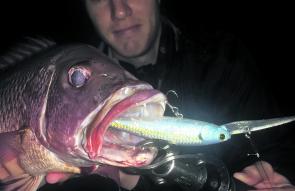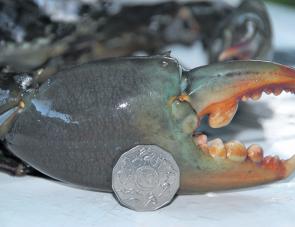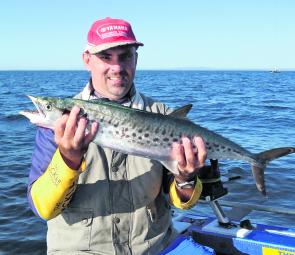With the festive season all but over and the kids now back at school there will now be a lot more space between boats out on the water. The chaos of the holiday period can at times quieten the fishing action due to the extra boating traffic including fishers, sailors, jet skiers and other boating enthusiasts.
As everything returns back to normal, anglers will start to see an increase in the quality of the fishing, especially around heavily populated inshore areas. The summer run of pelagics should be in full swing and the estuaries and river systems have plenty of fish and crustaceans on offer for those hitting the water during January.
Plenty of pelagics have been taken in recent months yet January often offers some of the best fishing for mackerel and the lesser tunas and bonito. Bait schools are generally common throughout Moreton Bay and this is what attracts the numerous pelagic species. This baitfish are generally a decent size, often up over 10cm in length, by this time of the year, which makes imitating the bait that much easier. The usual chromed slugs will work, as well as other offerings such as stick baits, poppers, jerk shad plastics, swimming minnows and numerous others. Most of these generally need to be retrieved fast to excite the pelagics and solicit a strike, therefore reels which will retrieve around a metre of line per turn of the handle are advisable.
After a drought of reasonably priced high-speed reels in recent years, there are now several moderately priced reels available on the market that will do the job. Many anglers now opt for smaller reels than those once used such as the now archaic Shimano TSS-4, as reel technology has come a long way and the thinness of braided line means that spools do not need to be as large. Match these reels with a high-modulus graphite rod, which is a powerful casting and fish fighting tool and you have a great quality spin outfit which is light, yet has all the attributes to get the job done.
Schools of mackerel can be located anywhere at any time throughout Moreton Bay so it pays to have a high-speed spin rod rigged and ready to cast whenever you are traveling throughout this area. Using fluorocarbon leaders, casting to the edges of the school and beginning your retrieve before your lure lands will go a long way in decreasing bite offs and increasing your catch rate when targeting surface feeding schools.
When jigging chromed offerings around the shipping channel beacons, use slugs and slices that will sink vertically and plummet into the strike zone quickly. This limits bite-offs while the lure sinks, as is often the case with many lures that flutter. Wire leaders are generally not advisable as they will virtually halt your strike rate.
Other techniques around the beacons and artificial reefs included drifting out pilchards, often under a float, while berleying with small slices of pilchard. The Measured Mile area is generally a popular place for this pursuit, especially on the early morning rising tides.
While most anglers hope to encounter, hook and land the prized longtail tuna, it is more likely that their quarry will be a mac tuna, frigate tuna, Watson bonito or Australian bonito during January, as these are a lot more common throughout Moreton Bay during the summer months.
The best of the longtail tuna action is generally between March and June, but there will still be a few around to target this month, generally larger individual specimens. These are sometimes seen surface feeding but are generally more commonly encountered by anglers using live baits, especially yakkas and slimy mackerel.
The other tuna and bonito species are also taken on live baits at times but due to their tendency to hunt in larger schools and surface feed on bait schools, anglers commonly cast small chromed slugs and slices, jerk shad plastics and baitfish profiled flies when in pursuit of them.
Snapper numbers should still be fairly good throughout January due to the influx of baitfish species that are commonly within the bay at this time of the year. Apart from being found in the usual places such as the artificial reefs, wrecks and around the grounds fringing the bay islands, snapper are sometimes found out in open water underneath the feeding frenzy of mackerel and tuna. In this situation they will commonly slurp up the wounded and injured baitfish left from the feeding melee.
A small jerk shad plastic allowed to sink underneath the feeding pelagics will often be slurped up by a quality snapper. Often snapper will even chase this bait into quite shallow water and are often seen surface feeding on hardiheads, gar and other baitfish around the edges of the bay islands (Peel, Green, Mud etc.). At Peel, the edges of the reef on the falling tide and the tops of the reef on the high tide will commonly hold quality snapper, however, be aware of the green zone restrictions in force around many areas of Peel. In addition to snapper, numerous other species including sweetlip, tuskfish, morwong, yellowtail kingfish and mackerel will be hooked around the reef edges.
The numerous estuarine, river and creek systems are also well worthwhile probing during the warmer months with bream, mangrove jack, trevally, estuary cod, tarpon, flathead and an array of others on offer.
Mangrove jack are a real prize for many serious estuarine anglers due to their aggressiveness and powerful strikes. Many anglers will lose the first few that they hook, which just seems to heighten their appeal and worthiness as a sportfishing target. An array of lures and live baits will work on these crimson assailants with most anglers having their personal favourites, based on previous success or the recommendations of others. However many different types and brands of lures will work well in the hands of anglers who fish them correctly.
Some lures are easier to present well in certain situations than others. Suspending minnow lures account for a lot of jacks with the strike often coming as the lure is paused. These are great for working around structure such as bridge pylons and pontoons.
Soft plastics offer a relatively cheap and effective offering for jacks and can be rigged in a weedless manner to allow them to be fished through heavy structure without fouling. Poppers can really lure jacks out away from their structure, especially around the extremities of the day, low light situations and when the barometer is rising, which increases their aggressiveness. Live baits offer a relaxed approach to jack fishing, whether land-based or working from a boat. Mullet, larger prawns, herring and numerous others will produce.
Live baits are also good offerings for a host of other estuarine species including estuary cod, trevally, flathead, threadfin salmon, large bream and others. All these species can be taken throughout our waterways during January and offer some great fun no matter whether you are chasing a feed or just sportfishing. Again, there are a host of lures that will produce the goods on these species.
Working the edges of major bank systems on the falling tide is likely to produce a few flathead. Estuary cod will be taken in many of the same areas as mangrove jack yet have a real preference for rocks walls, especially those sporting a healthy crab population. Trevally can be taken in a variety of areas, often in open water situations when baitfish are present along the edges of current lines and around current altering structure. Bream can be taken almost anywhere, from the sandy shallows to deep channels to the brackish upriver reaches.
Canals and harbours offer plenty of structure for baitfish and other species and are good places for those with kayaks and small craft, especially when the more open water conditions are not favourable. However, be aware that many have limitations on access and fishing.
The Brissie River has plenty of options for keen anglers, no matter whether you are fishing from the shore or watercraft. Land-based anglers commonly use live baits to target threadfin during the warmer months however they also encounter plenty of sharks, rays, catfish, pike eels and other undesirables. Occasionally however they will also catch a quality snapper, mulloway, estuary cod or flathead to add a little variety.
In some areas, lures can be used by anglers fishing from the shore. This is especially productive around bridges, pontoons, jetties and other areas that are lit at night however for results you will generally need to put in the kilometres and casts. Down towards the mouth is a popular area due to the good results that can be obtained and its close proximity to the ramps at Boat Passage and Pinkenba. Anglers commonly work lures or soak live and dead baits around areas such as Claras Rocks, the Oil Pipeline, the retaining wall of the southern bank at the river mouth, the Gateway Bridge and out from the numerous jetties (be aware of the restrictions).
During periods of heavy boat traffic the action often slows a little, however the activity of the large ships can often fire things up due to the enormous amount of water and bottom sediment that their large propellers can disturb. This dislodges worms and other food sources and can really create some hot fishing.
January offers some excellent opportunity to secure a feed of crabs. Both sand and mud crabs can be caught in safety pots and pick-up dillies (witches hat dillies have been illegal for several years now). Baiting these with baits such as chicken carcasses, fish frames, whole mullet and similar baits then setting them in likely spots is the key to success.
For muddies, try the upper reaches of the creeks and rivers. Hard to access drains and small creeks often produces some of the better quality bucks. Generally after heavy rain, the mud crabs can be found in better numbers in the main basin of the river. After the floods of recent years, many experience good mud crab catches as far out as Mud Island.
Generally however, these waters are the go for sand and blue swimmer crabs. Setting your crabbing apparatus along the ledges and contours wide of the bay islands and in the channels separating them is generally a recipe for success. Look at the kind of spots where commercial crabbers set their pots and go and find your own area, which has similar attributes. Both sand and mud crabs have different size limits, ways of measuring and bag limits so check the regulations relating to these, and your crabbing apparatus, before setting out.
Prawns can sometimes show up in better numbers during January however the best run of banana prawns is generally from late February to May. Anglers may still be able to secure a decent feed of these succulent morsels during January by working the deeper holes in systems such as the Logan River, Caboolture River, Burpengary Creek, Pine River and Brisbane River. Regardless there should be plenty of the smaller greasy prawns on offer and these make excellent baits for virtually every estuarine species and many bay demersals.
The conditions during January are often boiling hot and we generally receive some pretty awesome storms. This can really stir up the piscatorial action in many systems, especially during the build up to the storms when barometers are generally rising. The effects of the heat can take its toll quickly so ensure you take the relevant measures to avoid sunburn and dehydration.
With plenty of pelagics on offer throughout Moreton Bay and some awesome estuary dwellers such as jacks, flathead and threadfin on offer, you shouldn’t have too much trouble getting into some action. If a slower pace is more your thing then soak a few crab pots and take it easy. A cooling swim is sometimes a great way to break up the day. We are lucky to live in such a great part of the world with so much aquatic action on offer so get out there and make the most of it.
Reads: 1335
Deep diving and suspending lures are great offerings for jacks as they get down into the strike zone and entice them to strike.

A big succulent mud crab can definitely make the effort of setting a few safety pots worthwhile.

Spotted mackerel numbers should be on the rise during January and hopefully they will hang around until late May like they did last year.




